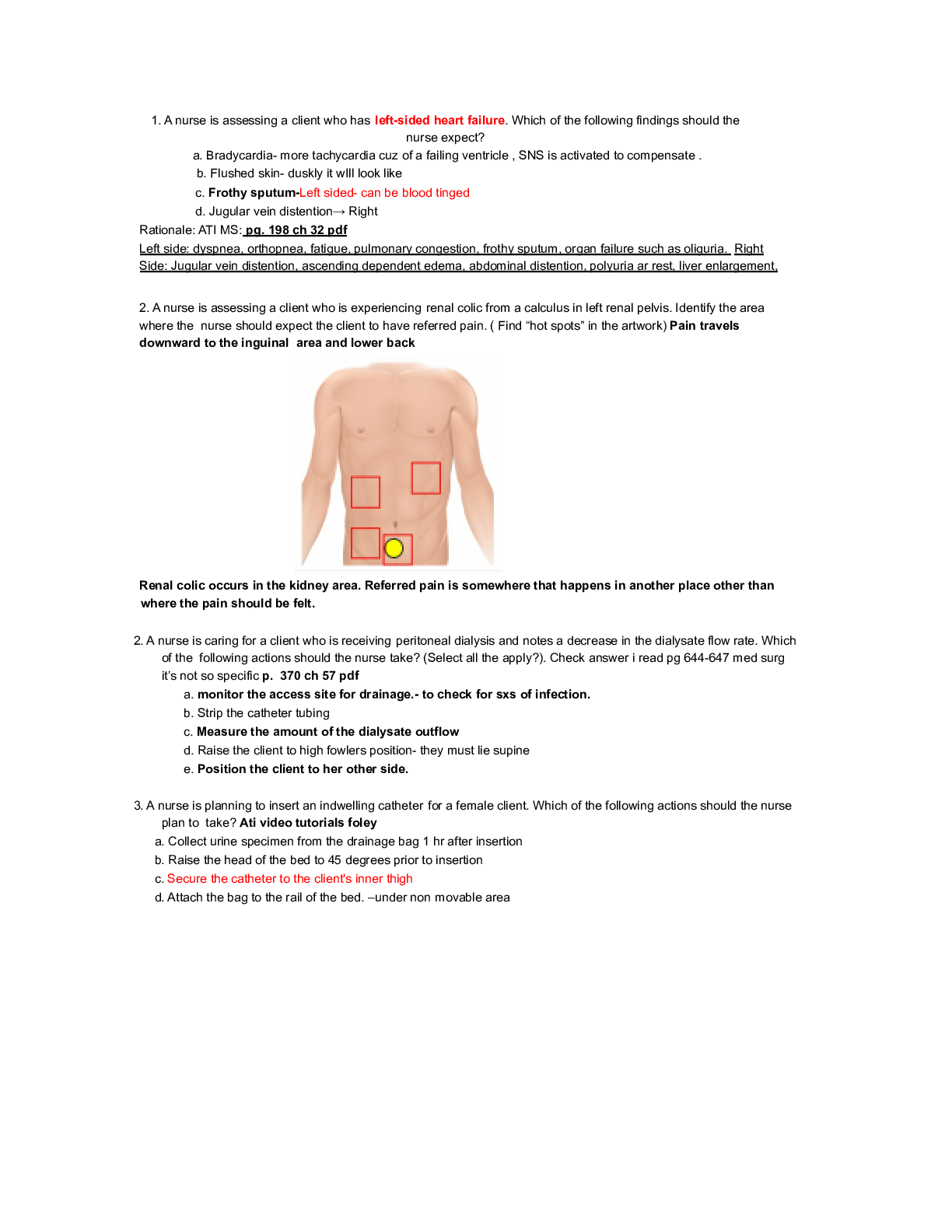1. A nurse is assessing a client who has left-sided heart failure. Which of the following findings should the nurse expect?
a. Bradycardia- more tachycardia cuz of a failing ventricle , SNS is activated to compensate .
b. Flushed skin- duskly it wIll look like
c. Frothy sputum-Left sided- can be blood tinged
d. Jugular vein distention→ Right
Rationale: ATI MS: pg. 198 ch 32 pdf
Left side: dyspnea, orthopnea, fatigue, pulmonary congestion, frothy sputum, organ failure such as oliguria.
Right Side: Jugular vein distention, ascending dependent edema, abdominal distention, polyuria ar rest, liver enlargement,
2. A nurse is assessing a client who is experiencing renal colic from a calculus in left renal pelvis. Identify the area where the
nurse should expect the client to have referred pain. ( Find “hot spots” in the artwork) Pain travels downward to the inguinal
area and lower back
Renal colic occurs in the kidney area. Referred pain is somewhere that happens in another place other than where the pain should
be felt.
2. A nurse is caring for a client who is receiving peritoneal dialysis and notes a decrease in the dialysate flow rate. Which of the
following actions should the nurse take? (Select all the apply?). Check answer i read pg 644-647 med surg it’s not so specific p.
370 ch 57 pdf
a. monitor the access site for drainage.- to check for sxs of infection.
b. Strip the catheter tubing
c. Measure the amount of the dialysate outflow
d. Raise the client to high fowlers position- they must lie supine
e. Position the client to her other side.
3. A nurse is planning to insert an indwelling catheter for a female client. Which of the following actions should the nurse plan to
take? Ati video tutorials foley
a. Collect urine specimen from the drainage bag 1 hr after insertion
b. Raise the head of the bed to 45 degrees prior to insertion
c. Secure the catheter to the client's inner thigh
d. Attach the bag to the rail of the bed. –under non movable area
6. A nurse is providing teaching for a client who has age-related macular degeneration which of the following information should the
nurse include in the teaching
a. A possible cause of this problem is long-term lack of dietary protein
b. You probably have a Detachment of your retina -vision is like having curtains over eyes
c. You probably have noticed a decline in your central vision
d. The doctor can perform surgery to correct the start paying the folds in your retina
Rationale: ATI MS: PG. 63 Macular degeneration, often called age-related macular degeneration (AMD), is the central loss of
vision that affects the macula of the eye. NO cure , happens alot in old people. Sxs: distorted vision, blurred vision, caused by
smoking, female, HTN, diet lacking carotene.
7. A nurse is assessing a client who has cirrhosis. Which of the following findings is the priority for the nurse to report? P . 357 ch 55
pdf Med surg
a. Platelets 70,000/mm3- risk of bleed normal range is 150,000 - 300,00- ABCS is compromised automatically .
b. Distended abdomen- expected
c. Alkaline phosphatase 125 units/L -norm normal is 30 -120 D. Clay colored stools- bile not on your shit
8. A nurse is preparing to discontinue long-term total parenteral nutrition (TPN) therapy for a client for a client. The nurse should plan
to discontinue the TPN gradually to reduce the risk of which of the following adverse effects? Old med surge docs we used
a. Hyperglycemia
b. Diarrhea
c. Constipation
d. Hypoglycemia (Repeat) Since your body is producing enough insulin to take on higher loads, you must taper it
down to avoid hypoglycemia with lower concentrations of
TPN
Abruptly discontinuing TPN will cause rebound hypoglycemia
9. A nurse is preparing to administer a unit of packed RBCs to a client. Which of the following actions should the nurse plan to take? P
. 250 chapter 40 pdf p . 678 lewis
a. Administer the unit of packed RBC’s over 1 hr- 2- 4 hr its must be given for 2 -4 hours. older adults
b. Obtain the client’s first set of vital signs 1 hr after initiating the transfusion- you get vital signs at the initial first 15 to 30
minutes of the transfusion.
c. Initiate venous access with a 21-gauge needle - no more than 19, for a regular adult it is 18 or 20 .
d. Use Y tubing with 0.9% sodium chloride when administering the transfusion. Pg 249
10. TOXIC SHOCK SYNDROME- same
Read More


